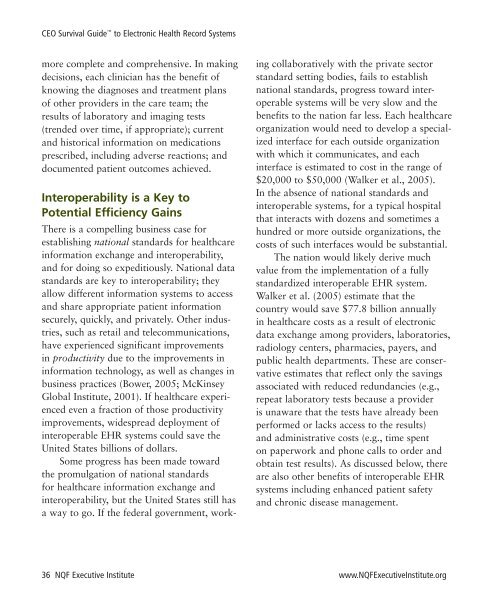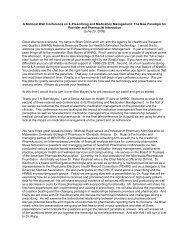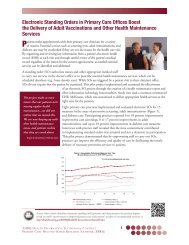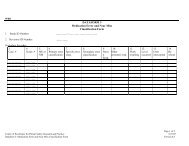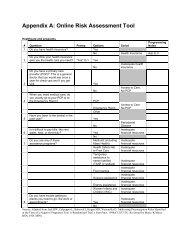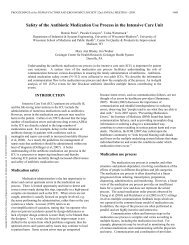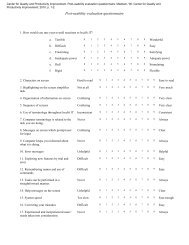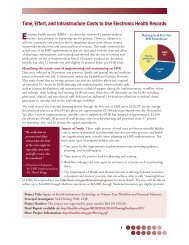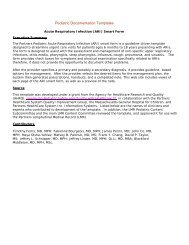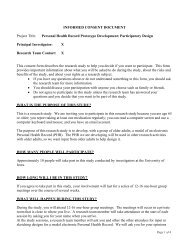CEO Survival Guide - AHRQ National Resource Center; Health ...
CEO Survival Guide - AHRQ National Resource Center; Health ...
CEO Survival Guide - AHRQ National Resource Center; Health ...
You also want an ePaper? Increase the reach of your titles
YUMPU automatically turns print PDFs into web optimized ePapers that Google loves.
<strong>CEO</strong> <strong>Survival</strong> <strong>Guide</strong> to Electronic <strong>Health</strong> Record Systemsmore complete and comprehensive. In makingdecisions, each clinician has the benefit ofknowing the diagnoses and treatment plansof other providers in the care team; theresults of laboratory and imaging tests(trended over time, if appropriate); currentand historical information on medicationsprescribed, including adverse reactions; anddocumented patient outcomes achieved.Interoperability is a Key toPotential Efficiency GainsThere is a compelling business case forestablishing national standards for healthcareinformation exchange and interoperability,and for doing so expeditiously. <strong>National</strong> datastandards are key to interoperability; theyallow different information systems to accessand share appropriate patient informationsecurely, quickly, and privately. Other industries,such as retail and telecommunications,have experienced significant improvementsin productivity due to the improvements ininformation technology, as well as changes inbusiness practices (Bower, 2005; McKinseyGlobal Institute, 2001). If healthcare experiencedeven a fraction of those productivityimprovements, widespread deployment ofinteroperable EHR systems could save theUnited States billions of dollars.Some progress has been made towardthe promulgation of national standardsfor healthcare information exchange andinteroperability, but the United States still hasa way to go. If the federal government, workingcollaboratively with the private sectorstandard setting bodies, fails to establishnational standards, progress toward interoperablesystems will be very slow and thebenefits to the nation far less. Each healthcareorganization would need to develop a specializedinterface for each outside organizationwith which it communicates, and eachinterface is estimated to cost in the range of$20,000 to $50,000 (Walker et al., 2005).In the absence of national standards andinteroperable systems, for a typical hospitalthat interacts with dozens and sometimes ahundred or more outside organizations, thecosts of such interfaces would be substantial.The nation would likely derive muchvalue from the implementation of a fullystandardized interoperable EHR system.Walker et al. (2005) estimate that thecountry would save $77.8 billion annuallyin healthcare costs as a result of electronicdata exchange among providers, laboratories,radiology centers, pharmacies, payers, andpublic health departments. These are conservativeestimates that reflect only the savingsassociated with reduced redundancies (e.g.,repeat laboratory tests because a provideris unaware that the tests have already beenperformed or lacks access to the results)and administrative costs (e.g., time spenton paperwork and phone calls to order andobtain test results). As discussed below, thereare also other benefits of interoperable EHRsystems including enhanced patient safetyand chronic disease management.36 NQF Executive Institute www.NQFExecutiveInstitute.org


